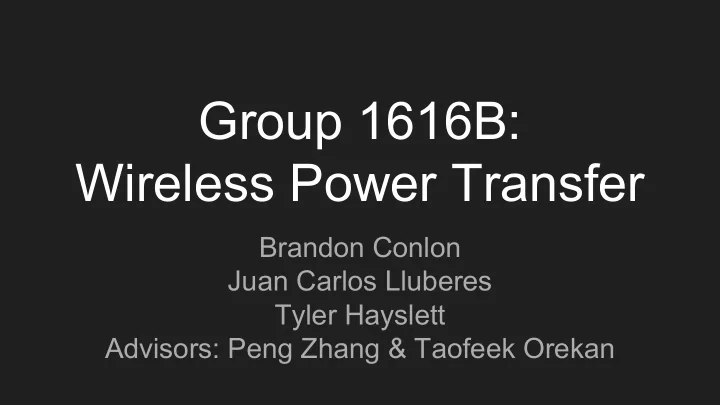

Group 1616B: Wireless Power Transfer Brandon Conlon Juan Carlos Lluberes Tyler Hayslett Advisors: Peng Zhang & Taofeek Orekan
System Overview Frequency adjustable subsea Resonant Wireless Power transfer System
Frequency determination ● In tank tests show decreasing efficiency with increasing frequency ● 20 kHz range close enough to air to give similar results ● WPT generally in MHz
Frequency increase comparison
Additional preliminary testing ● Along with the marine testing, the addition of booster coils added approximately 1.75dB to received signals at all distances, extending range. ● All data shown was taken with full 4 coil circuit.
Testing equipment ● Testing conducted in water fixed to average Atlantic Ocean salinity with aquarium salt (~3.5% salt) ● Low amplitude sine wave applied to Tx coil arranged in series with capacitor. ● All other coils arranged as tank circuits, measurements taken over capacitor.
ANSYS Maxwell (Guidance form Taofeek Orekan) ● In WPT coil shape and size has an enormous effect on transmission efficiency. ● Simulation targeted high coupling coefficient in a modeled salt water environment. ● Several factors all have interrelating effects on coupling coefficient. ○ Coil shape, radius, wire diameter, wire spacing, and separation distance ● ANSYS allowed for accelerated testing with automated sweeps for different variables.
General distance curve ● Coupling Coefficient is exponentially decreasing with distance as verified in lab testing.
Turn Count and Coil Diameter ● As turn count increases, so does Coupling Coefficient, but with obvious diminishing returns. ● Coil resistance, and wire thickness/diameter limit maximum. ● Improvements are less than .001 by ~20 turns. ● Coupling coefficient increases with area. ● All distances held to scale, CC still increases. ● Size limited by AUV, 100mm goal
Types of coils (Pictures of coil shapes)
Coil Coupling comparison
Magnetic Field visualization
Effect of pitch ● Optimal pitch ~1.4mm for 100mm coil ● Measurable reception possible out to ~10cm
Coil Design ● 100mm diameter, 20 turn, 35.6uH transmitter and receiver coils ● 20ga copper wire with .25mm jacket for ~1.32 pitch ● Spiral shape, with space in center. ● Operating at 20kHz, skin depth is 27kHz for 20ga ● 3D printed center spacer (ME Michael Bennett) ● Attached to plexiglass backing for testing
Coil Design notes ● Slightly smaller pitch in order to be physically realized. ● Ferrite backing/core could additionally improve coupling .
Mutual Inductance and Frequency ● Inductor pairing creates a higher order system. ● Resonance splits in two ○ One pole races off to infinity, the other slowly decays ○ Much easier to adjust to match the lower frequency https://www.desmos.com/calculator/xhhr55y466 http://tsgphysics.mit.edu/pics/L%20LC%20and%20RLC%20Circuits/L5/L5_5.jpg
Controls ● ATmega328P chip ○ Allows for up to 3 PWM signals ○ 16MHz won’t limit switching for H-Bridge operation ○ Programmable nature allows for frequency change to maintain resonance ● Output is 40mA@5V, so intermediary MOSFET drivers are needed to drive H- Bridge ● To eliminate shoot through, generated waveforms are timed to switch P-FET off fully before attempting to switch N-FET on. ● Reduced precision for two of the PWM signals ● High precision signal prevents shoot through, lower precision signal switches direction.
Control Signals ● Fast switching Logic gates (<20ns) correct controller output for MOSFET drivers.
Power Inverter Specification ● 13.8V from WEC battery ● >=20kHz operation ● Driven by 5V input signals ● High efficiency ● Low cost
Component Selection ● While the battery voltage is only about 13.8 at the most, the reactive nature of the load requires that the MOSFETs have both a large margin of error and clamping diodes. ● To minimize both switching times and peak switching current, low Qg MOSFETs were chosen. (total switching speed, ~200ns) ● The MOSFET drivers were chosen for both their propagation speed and their peak current of 9A. ● Worst case gate current for the two FETs selected
H-Bridge simulation ● Correct capacitance for 20kHz resonance calculated to be 1.78uF. ● Simulation of whole system was run to ensure correct operation.
H-Bridge testing ● Similar to transients coming off microcontroller, higher amplitude and sudden current draw caused output oscillation over MOSFET drivers.
Noise/Harmonic Suppression ● Operation resulted in large ringing and unwanted transient spikes when switching gates. ● Small capacitors added across MOSFET driver rails, as well as a large one across the battery terminals. ● Current limiting resistors were added to the FET gates.
Final H-Bridge Circuit
Successful operation
Bubba Inverter Circuit • • • •
Alternative Options ● FM transmitters can output up to megawatts of power. ● This one by CZHFM outputs up to 25W of power with a 60W input. ● This is an efficiency of only 42 percent before the wave is transmitted or rectified still too large of a loss for our applications. ● These are also extremely expensive with this model costing $500.
H-Bridge Inverter Circuit • • • •
H Bridge continued ● The mutual inductance of the transmission coil with the receiving coil will decrease as the coupling factor of the two coils falls below 1 shown by the equation. ● This will alter the resonant frequency of the LC circuit to Which can be matched in real time by the frequency of switching in the MOSFETS to accompany for changes in distance in the circuit.
Power Electronics ● Simulation assumes receiver retains 12V @ 20 kHz ● Schottky diodes w/ voltage drop <. 52 V ● Smoothing capacitor to ensure full wave is rectified ● Time constant (1/RC) << signal frequency ● Time Const. = 1,000
Power Electronics ● Without meeting this time constant condition, we cannot fully convert to a DC voltage ● Here Time Const. = 10,000
Questions?
Recommend
More recommend